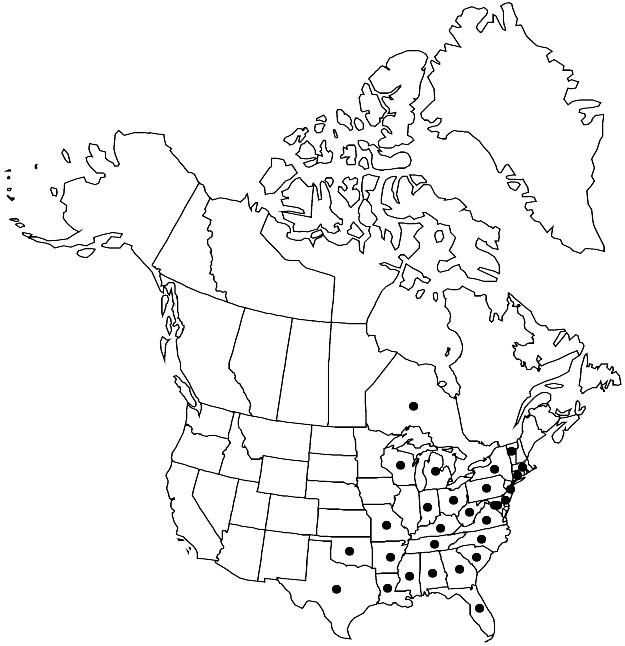Difference between revisions of "Forsstroemia trichomitria"
Öfvers. Kongl. Vetensk.-Akad. Förh. 19: 605. 1863.
FNA>Volume Importer |
FNA>Volume Importer |
||
| Line 10: | Line 10: | ||
|name=Pterigynandrum trichomitrion | |name=Pterigynandrum trichomitrion | ||
|authority=Hedwig | |authority=Hedwig | ||
| + | |rank=species | ||
|publication_title=Sp. Musc. Frond., | |publication_title=Sp. Musc. Frond., | ||
|publication_place=82, plate 16, figs. 1 – 6. 1801 | |publication_place=82, plate 16, figs. 1 – 6. 1801 | ||
| Line 16: | Line 17: | ||
|name=Leptodon trichomitrius | |name=Leptodon trichomitrius | ||
|authority=(Hedwig) Sullivant & Lesquereux | |authority=(Hedwig) Sullivant & Lesquereux | ||
| + | |rank=species | ||
}} {{Treatment/ID/Synonym | }} {{Treatment/ID/Synonym | ||
|name=L. trichomitrius var. floridanus | |name=L. trichomitrius var. floridanus | ||
|authority=(Lindberg) Grout | |authority=(Lindberg) Grout | ||
| + | |rank=variety | ||
}} {{Treatment/ID/Synonym | }} {{Treatment/ID/Synonym | ||
|name=L. trichomitrius var. immersus | |name=L. trichomitrius var. immersus | ||
|authority=(Sullivant & Lesquereux) Sullivant | |authority=(Sullivant & Lesquereux) Sullivant | ||
| + | |rank=variety | ||
}} | }} | ||
|hierarchy=Leptodontaceae;Forsstroemia;Forsstroemia trichomitria | |hierarchy=Leptodontaceae;Forsstroemia;Forsstroemia trichomitria | ||
| Line 46: | Line 50: | ||
-->{{#Taxon: | -->{{#Taxon: | ||
name=Forsstroemia trichomitria | name=Forsstroemia trichomitria | ||
| − | |||
|authority=(Hedwig) Lindberg | |authority=(Hedwig) Lindberg | ||
|rank=species | |rank=species | ||
| Line 61: | Line 64: | ||
|publication year=1863 | |publication year=1863 | ||
|special status= | |special status= | ||
| − | |source xml=https://jpend@bitbucket.org/aafc-mbb/fna-data-curation.git/src/ | + | |source xml=https://jpend@bitbucket.org/aafc-mbb/fna-data-curation.git/src/f50eec43f223ca0e34566be0b046453a0960e173/coarse_grained_fna_xml/V28/V28_981.xml |
|genus=Forsstroemia | |genus=Forsstroemia | ||
|species=Forsstroemia trichomitria | |species=Forsstroemia trichomitria | ||
Revision as of 21:19, 16 December 2019
Stem and branch leaves lanceolate, ovate-lanceolate, broadly ovate-lanceolate, oval, or deltoid, 1–3 × 0.5–1.2 mm; costa single, weak, 1/4–3/4 leaf length, or double, short; laminal cells fusiform to linear, 4–8:1; medial cells 25–80 × 5–11 µm. Sexual condition autoicous, often gonioautoicous. Seta 0.4–3.9 mm. Capsule immersed to exserted, 1–2.3 × 0.4–1 mm; operculum 0.5–1.1 × 0.3–0.6 mm; exostome teeth smooth, minutely papillose, or occasionally granulose. Spores 18–30 µm.
Phenology: Capsules mature winter.
Habitat: Epiphytic, boles of hardwood trees, rock, bark of evergreen trees, shaded, relatively humid areas, along streams
Elevation: low to high elevations
Distribution

Ont., Ala., Ark., Conn., Del., D.C., Fla., Ga., Ind., Ky., La., Md., Mass., Mich., Miss., Mo., N.J., N.Y., N.C., Ohio, Okla., Pa., S.C., Tenn., Tex., Vt., Va., W.Va., Wis., Mexico, South America, e Asia, e Australia.
Discussion
Immersed capsules (with short setae) are very common in Forsstroemia trichomitria in the states bordering the Gulf of Mexico. However, from Virginia northward, capsules are nearly always either emergent or exserted. The two North American species of Forsstroemia rarely may form hybrids that have intermediate features of medial laminal cell length, costal length, frequency of single costae, seta length, post-fertilization perichaetial leaf length, and peristome appearance (L. R. Stark 1987). The secondary stems are usually subpinnate.
Selected References
None.